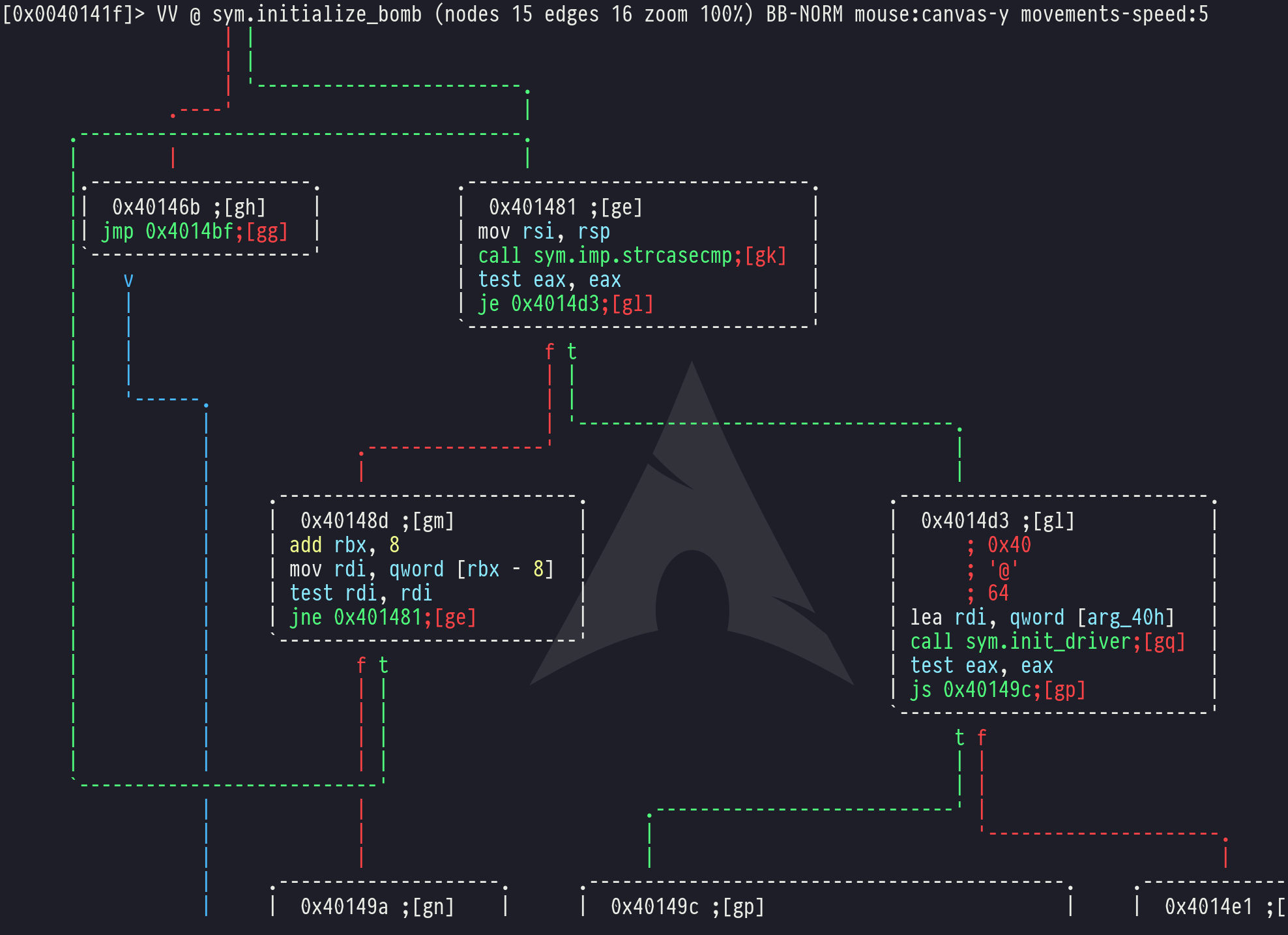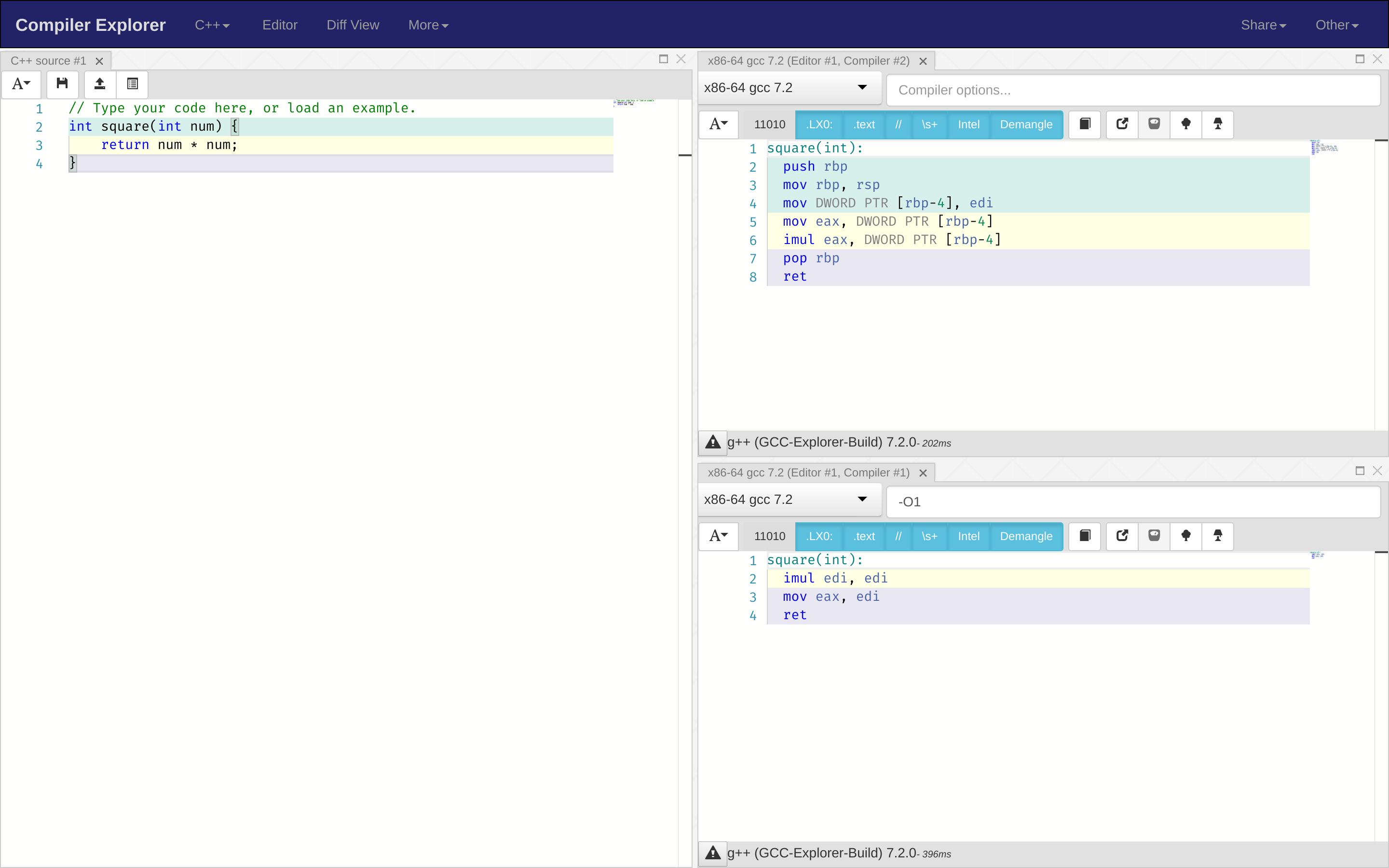Helpful Tools for CSCI2021
radare2
radare2 can replace GDB, and has many more analysis tools.
Installing
Check your repos. It's in the repos for Arch, Ubuntu, and Homebrew (for you macOS kids).
Example of Usage
Start radare2 with radare2 -d <program>.
Radare2 has very terse commands, unlike GDB. Reading a tutorial is highly, highly, highly recommended; try this one.
However, here's a cool demo of one of the more useful things. Load your bomblab file with the above commands.
Then run the commands:
aaa
VV @ sym.initialize_bomb
You can now use the arrow keys or Vim-style hjkl scrolling to pan around the control-flow graph of your bomb.

godbolt
godbolt is a useful online tool for reading the assembly output of C code. It highlights the lines different blocks of assembly come from too, which makes reading it much easier.
Protip: Use -O1 in the "Compiler Flags" field -- it makes the code a lot more efficient without sacrificing much readability (and sometimes improving it).

clang
Clang gives much better error messages than GCC. Just replace gcc in your commands with clang. It's the default C compiler on macOS, and is installed on the CSELabs machines (and again is probably in your standard repos).
For example, instead of:
gcc -o main main.c
run
clang -o main main.c
Useful flags
Other flags that can check your code include:
-Wall-- add more warnings for incorrect (and likely to crash) code-g-- emit debug information into the program, so you can debug it easier
valgrind
Valgrind can help find the causes of segmentation faults and memory leaks a lot better than most programmers. Run your program with it to find them.
For example, instead of:
./main
run
valgrind ./main
Installing
Check your repos.
Reading Valgrind's output
After running valgrind, you might get output like:
==30038== Memcheck, a memory error detector
==30038== Copyright (C) 2002-2017, and GNU GPL'd, by Julian Seward et al.
==30038== Using Valgrind-3.13.0 and LibVEX; rerun with -h for copyright info
==30038== Command: ./a.out
==30038==
==30038== Invalid read of size 1
==30038== at 0x108611: main (main.c:3)
==30038== Address 0x0 is not stack'd, malloc'd or (recently) free'd
==30038==
==30038==
==30038== Process terminating with default action of signal 11 (SIGSEGV): dumping core
==30038== Access not within mapped region at address 0x0
==30038== at 0x108611: main (main.c:3)
==30038== If you believe this happened as a result of a stack
==30038== overflow in your program's main thread (unlikely but
==30038== possible), you can try to increase the size of the
==30038== main thread stack using the --main-stacksize= flag.
==30038== The main thread stack size used in this run was 8388608.
==30038==
==30038== HEAP SUMMARY:
==30038== in use at exit: 0 bytes in 0 blocks
==30038== total heap usage: 0 allocs, 0 frees, 0 bytes allocated
==30038==
==30038== All heap blocks were freed -- no leaks are possible
==30038==
==30038== For counts of detected and suppressed errors, rerun with: -v
==30038== ERROR SUMMARY: 1 errors from 1 contexts (suppressed: 0 from 0)
[1] 30038 segmentation fault (core dumped) valgrind ./a.out
This may look difficult to read, but the important part is the middle section:
==30038== Invalid read of size 1
==30038== at 0x108611: main (main.c:3)
==30038== Address 0x0 is not stack'd, malloc'd or (recently) free'd
Let's break this down line-by-line.
Invalid read of size 1
The error in your program is that it tried to read one byte from memory in a way that was invalid.
The only common one-byte type is a char, so we can be pretty sure that it was that.
at 0x108611: main (main.c:3)
You can ignore 0x108611 -- it's the memory address the code was at. If it's the only piece of information present, you might've tried to call a string as a function or something similar. Otherwise, the other two pieces of information are much more useful.
We know that it's in the main function, specifically at line 3 of main.c. If a line number isn't present, compile your program with -g and run it again.
Address 0x0 is not stack'd, malloc'd or (recently) free'd
From this, we know that the memory address we couldn't read from was 0x0. Since this is NULL, we know that we're trying to read from a null pointer. not stack'd, malloc'd or (recently) free'd tells us that this pointer is neither a stack nor a heap pointer, which is obviously true for NULL.
NASM
NASM is an assembler that is often preferred to GAS (the assembler taught directly in class). It uses the more intuitive Intel syntax rather than the AT&T syntax used by GAS, and is versatile enough to have your entire attacklab payload be created from a single assembly file, rather than needing to stich together a bunch of printf calls with cat.
Intel vs. AT&T Syntax
C version:
int main(void) {
int n = 20;
while(n != 1) {
if(n % 2 == 0) {
n = n / 2;
} else {
n = 3 * n + 1;
}
}
return n - 1;
}
GAS/AT&T Syntax version:
main:
movl $20, %eax # int n = 20;
jmp .test # while(n != 1) {
.loop:
testl $1, %eax
jz .if_true # if(n % 2 == 0)
.if_true: # {
shrl $1, %eax # n = n / 2;
jmp .test # }
.if_false: # else {
leal 1(%rax, %rax, 2), %eax # n = 3 * n + 1;
.test: # }
cmpl $1, %eax
jne .loop # }
.end:
dec %eax # return n - 1;
ret
Intel Syntax version:
main:
mov eax, 20 ; int n = 20;
jmp .test ; while(n != 1) {
.loop:
test eax, 1
jz .if_true ; if(n % 2 == 0)
.if_true: ; {
shr eax, 1 ; n = n / 2;
jmp .test ; }
.if_false: ; else {
lea eax, [eax + 2*eax + 1] ; n = 3 * n + 1;
.test: ; }
cmp eax, 1
jne .loop ; }
.end:
dec eax ; return n - 1;
ret
As you can see, the Intel syntax version is more C-like (n = 20 becomes mov eax, 20), and has less visual noise (20 is obviously a number, you don't need to call it $20). This is especially noticeable in the lea instructions corresponding to n = 3 * n + 1:
; Intel
lea eax, [eax + 2*eax + 1]
# AT&T
leal 1(%rax, %rax, 2), %eax
I really have no idea what the person who came up with 1(%rax, %rax, 2) was thinking...
Misc. Tips
Argument Passing Order
The mnemonic to remember is:
- Diane's
- Silk
- Dress
- Cost
- 8
- 9
- $
From first to last, these are:
rdirsirdxrcxr8r9- The $ tack
So if we have the code:
int foo(int x, unsigned int y, char* z);
int main(void) {
foo(1, 2, NULL);
return 0;
}
This will turn into the assembly:
main:
; MOVing to a register that starts with e
; will clear the upper half of the r register
; that it corresponds to.
mov edi, 1
mov esi, 2
xor edx, edx ; Or `mov edx, 0'
call foo
; return 0
xor eax, eax
ret